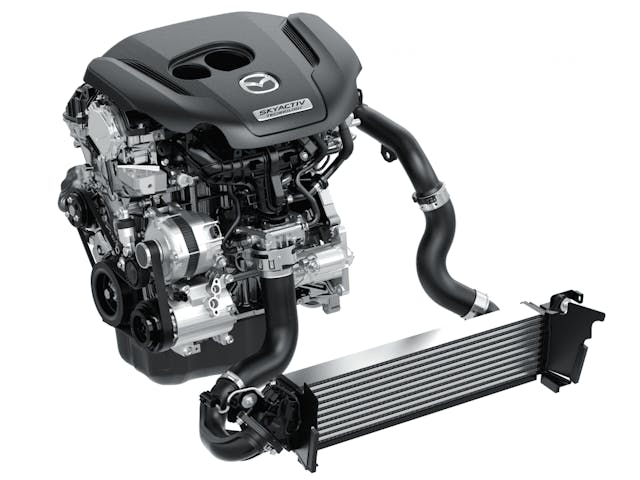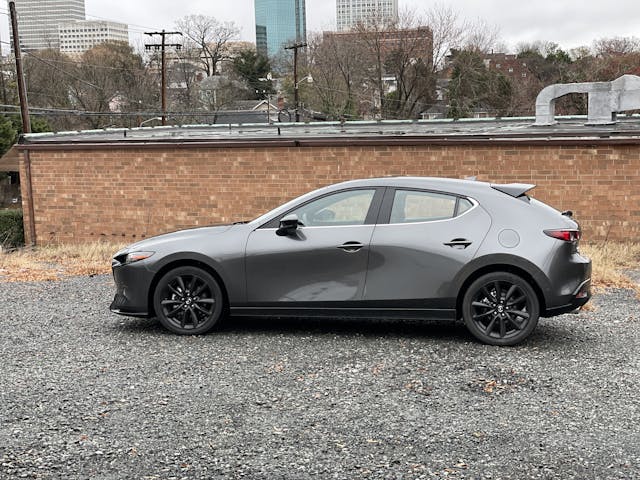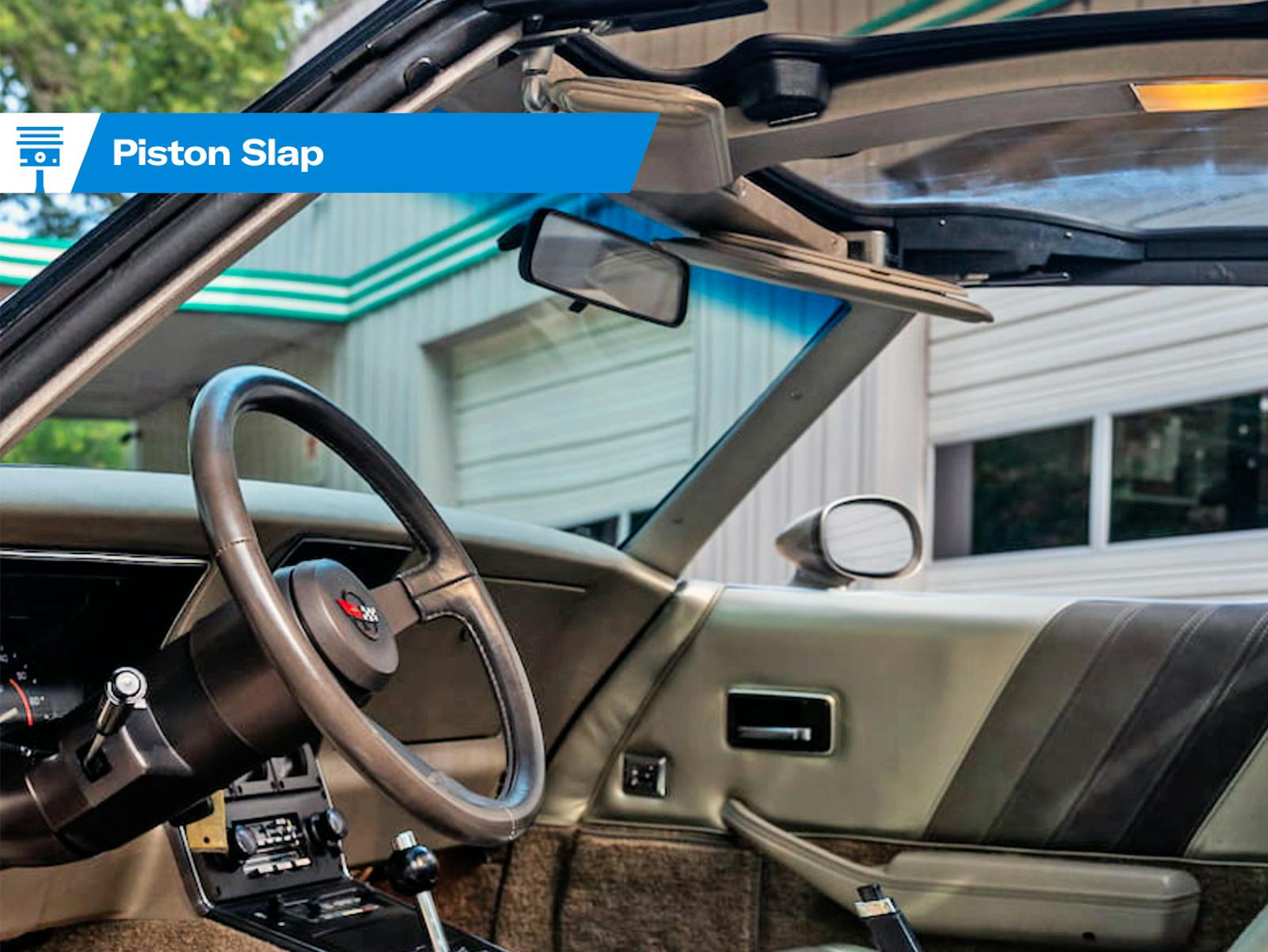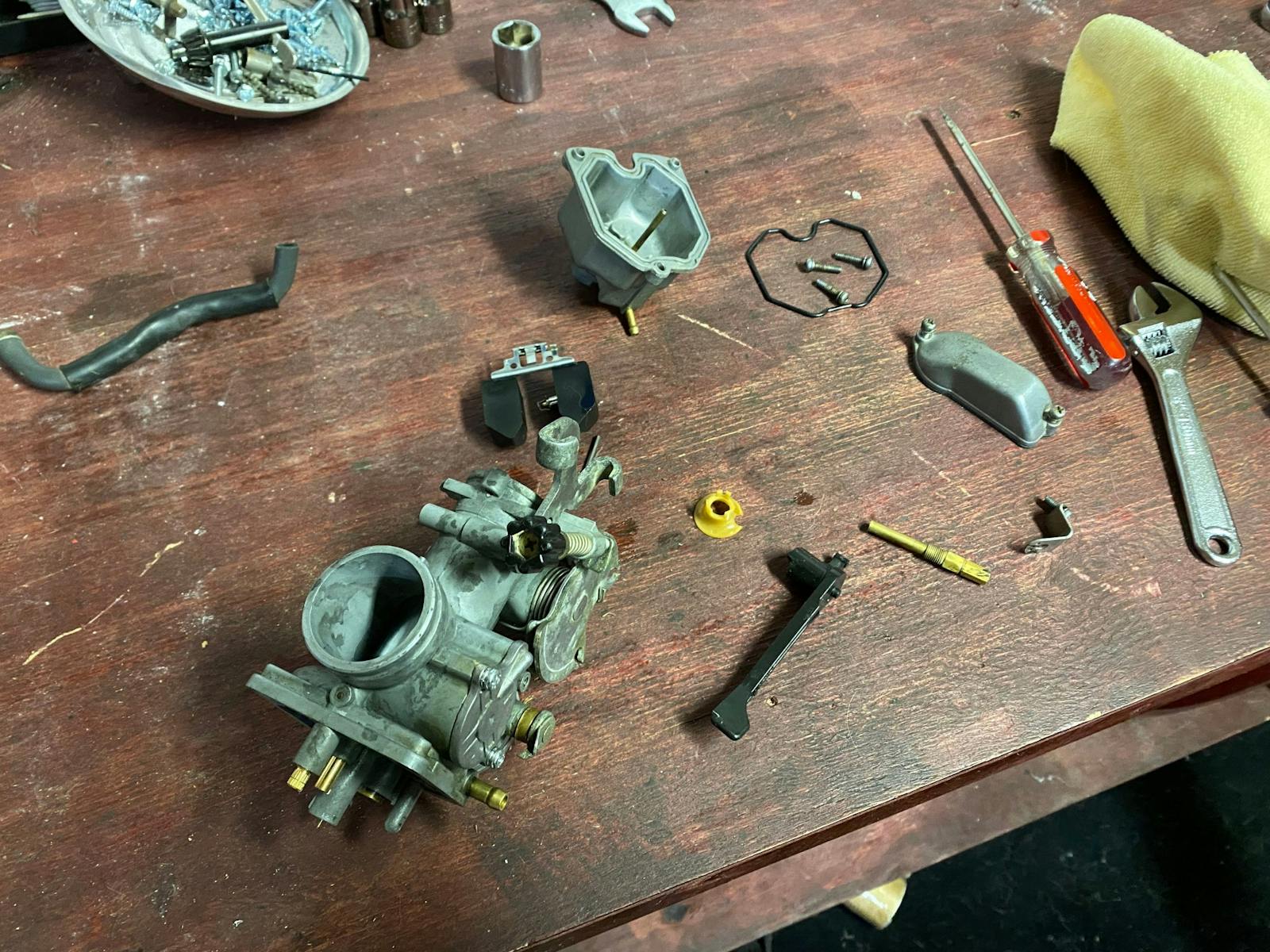2021 Mazda 3 2.5T AWD: A tech breakdown

As we predicted when Mazda first revealed it would be adding turbo power to the ever-entertaining 3 compact, the car didn’t turn out to be the hot-hatch Mazdaspeed3 reborn. But this grown-up version of the hot hatch provides its own type of fun, and a lot of that has to do with how it’s engineered and designed.
[This breakdown dives into some of the Mazda 3’s technical aspects. For more focused driving impressions, please check out Sam Smith’s review here. –Ed.]
The more adult-focused hatch, starting at $32,045, employs a 2.5-liter turbocharged engine to send power through a six-speed automatic transmission and on to all four wheels, without the manual option offered on base versions of the Mazda 3. The turbo engine, shared with the Mazda 6 and CX-9, produces 227 horsepower and 310 pound-feet of torque when fueled with 87 octane, but those figures jump to 250 horsepower and 320 pound-feet of torque if filled with 93 octane.

Some might be surprised that the Mazda 3 2.5 Turbo can get to 60 mph in roughly the same time as the old Mazdaspeed3 even though it produces 13 fewer horsepower. The secret lies partly in the gearing and partly in the design of the turbocharger. The Mazdaspeed3 used a fairly traditional single-scroll turbocharger, so lag was noticeable. The modern Mazda 3 2.5 uses a so-called Dynamic Pressure Turbo (DPS) system, featuring an exhaust manifold and turbocharger design that combines the best features of a twin-scroll and variable geometry turbocharger in one package.
Here’s how the DPS works: The exhaust manifold combines the middle two cylinders into the same branch, before moving into the collector that leads into the turbocharger. This resulting configuration (4-3-1) allows the exhaust pulses to be equalized and produce the same effect as a twin-scroll manifold—without the cost and weight of using a twin-scroll turbocharger. In addition to the manifold design, the DPS system also has series of valves positioned immediately before the turbocharger. At low rpm, the valves close in order to direct exhaust gasses into smaller passages, which is what helps the turbo respond off the line. Once the revs get high enough, the valves open and the turbo can operate as usual.
In pursuit of efficiency, all of these turbocharger advancements are combined with what is considered a fairly high compression ratio (10.5:1). While that compression ratio is especially high for a turbocharged engine that can run on regular octane, Mazda balances it with other technologies like cooled exhaust gas recirculation (EGR). EGR takes some of inert exhaust gas left over from the combustion process and pushes it through an intercooler before sending it back to the intake as a means of lower combustion temperatures. This way, boost and high compression can coexist without detonation (knock).

The six-speed automatic is a little sluggish, but flipping the switch for Sport mode—or even just driving on twisty roads—enables a special system that makes the powertrain feel much more in harmony with the holistic driving experience. G-Vectoring Control Plus, as Mazda calls it, is software that responds to steering angle with subtle adjustments to the engine power, transmission, and brakes. While there is some measurable handling improvement going on here, part of the philosophy is to improve the driver’s sensation of smoothness and control, which leads to a better driving and handling experience. If it’s working well, the whole point is for it to be unnoticeable. On a curvy road, the transmission smoothly downshifts under braking as I entered corners rather than shifting mid-corner, which would disturb the car and potentially unsettle the driver.
That assured handling on twisty roads is a testament to how well this chassis is tuned. The 3 handles brilliantly even with the added weight of the turbo engine and rear differential for the all-wheel drive system. Part of that solution involves stiffer springs and damping adjustments over the base car, compensating for mass, and the rest is related to how the car is programmed to distribute torque to that rear differential. The latter refinement offers the biggest difference over the Mazdaspeed3; here I experienced no apparent torque steer, with handling performance being fairly equal across the torque band.
Steering is fairly tight-feeling and Mazda actually stiffened the front suspension in order to compensate for the additional weight over the base car. While the steering is fairly responsive in usual Mazda fashion, it feels like there is a lot of room for improvement on feel. In all likelihood, the relatively uncommunicative setup is a compromise for customers who want more luxury compact than hot hatch. Grown up, remember?

A quieter ride is part of that maturity formula, and the car’s Bridgestone Turanza EL440 tires shoulder much of the load. That I barely noticed them at all during my drive says a lot about their intended purpose: isolation. This size and treadwear rubber is used on large hybrid sedans. Those that want a little more responsiveness on their weekend drives would do well to swap on a more aggressive tire, but exercise caution with any suspension modifications. Most aftermarket suspension components on the market are aimed at the front-wheel-drive models, and they likely won’t be a good match for the additional weight from the turbo engine and all-wheel-drive system.
Despite the various changes to refine the Mazda 3, the car wisely balances luxury and fun. Curvy roads are legitimately fun in this reasonably affordable, comfortable commuter, which is something you can’t say about most mainstream compacts today.

